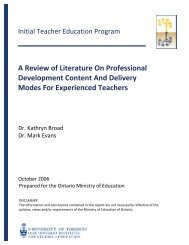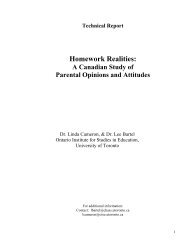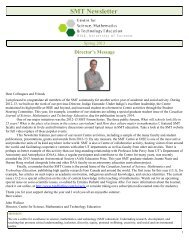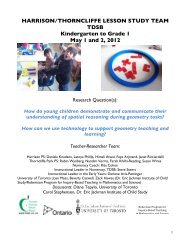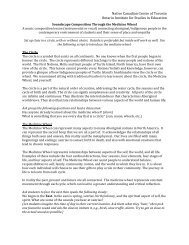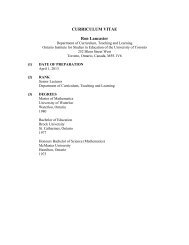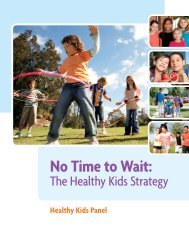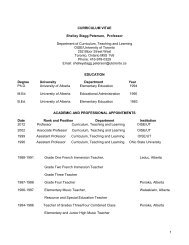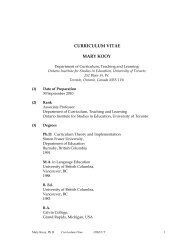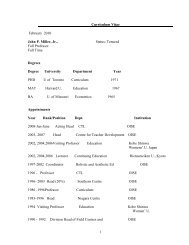The Ontario Curriculum, Grades 9-12 - Ministère de l'éducation ...
The Ontario Curriculum, Grades 9-12 - Ministère de l'éducation ...
The Ontario Curriculum, Grades 9-12 - Ministère de l'éducation ...
Create successful ePaper yourself
Turn your PDF publications into a flip-book with our unique Google optimized e-Paper software.
matter content, water content, water-holding capacity, nutrient content, porosity, and/or<br />
bulk <strong>de</strong>nsity of soil from a forest or meadow and soil from a gar<strong>de</strong>n or farmer’s field that<br />
has been treated with chemical fertilizer) [IP, PR, AI]<br />
B2.3 plan and conduct an inquiry, using appropriate technology, to compare water quality in<br />
natural and disturbed environments (e.g., compare the pH, ion content, temperature,<br />
dissolved oxygen content, hardness, turbidity, biological oxygen <strong>de</strong>mand [BOD], and/or<br />
fecal coliform of tap water, water from a pond or stream, and water from a drainage<br />
ditch) [IP, PR, AI]<br />
B2.4 analyse and interpret data on particulate matter in air samples from several different<br />
regions of Canada, using prepared data from a variety of sources (e.g., the <strong>Ontario</strong><br />
Ministry of the Environment – Air Quality <strong>Ontario</strong>, Environment Canada) [AI]<br />
B2.5 plan and conduct a waste audit of their home or school [IP, PR]<br />
B3. Un<strong>de</strong>rstanding Basic Concepts<br />
B3. <strong>de</strong>monstrate an un<strong>de</strong>rstanding of some of the ways in which human activities affect the<br />
environment and how the impact of those activities is measured and monitored<br />
B3.1 i<strong>de</strong>ntify the basic components of soil, water, and air, and <strong>de</strong>scribe some of the effects of<br />
human activity on soil, water, and air quality (e.g., the effects of industrial or vehicle<br />
emissions on air quality; of chemical spills on soil quality; of chlorination on water quality)<br />
B3.2 explain the concept of the cycling of substances in ecosystems (e.g., fertilizers ma<strong>de</strong> from<br />
biosolids leach into ground water or run off into rivers and streams, where the chemicals<br />
are absorbed by aquatic life, which is in turn consumed by humans)<br />
B3.3 explain common methods of sampling soil, water, and air for analysis (e.g., soil core<br />
sampling, <strong>de</strong>pth integrated sampling, stack sampling systems) and of monitoring soil,<br />
water, and air quality over time<br />
B3.4 explain the concept of a “carbon footprint” and how it is used to measure the impact on<br />
the environment of a range of human activities<br />
B3.5 explain the effects of human activity on an aquatic or terrestrial ecosystem (e.g., the<br />
impact of fertilizer run-off, acid precipitation, or an oil spill on an aquatic ecosystem)<br />
B3.6 explain how human activities (e.g., agriculture, travel, the purchase of exotic pets,<br />
importing and exporting, releasing domesticated fish into fresh water environments, the<br />
use of live bait) have led to the introduction of invasive species, and why it is important<br />
to measure and monitor the impact of invasive species on native species<br />
C. Human Health and the Environment<br />
C1. Relating Science to Technology, Society, and the Environment<br />
C1. analyse the effects on human health of environmental contaminants and a significant<br />
environmental phenomenon<br />
C1.1 assess, on the basis of research, the effects on human health of a significant<br />
environmental phenomenon (e.g., the ice storm of 1998 in central Canada, the European<br />
heatwave of 2003), and communicate their findings [IP, PR, AI, C]<br />
Sample issue: In August 2005, Hurricane Katrina <strong>de</strong>stroyed the levees surrounding New<br />
Orleans. Hundreds of people were drowned in the resulting floods. Many survivors<br />
contracted skin and gastro-intestinal diseases from contaminated water.<br />
140 Environmental Education, <strong>Gra<strong>de</strong>s</strong> 9−<strong>12</strong>: Scope and Sequence of Expectations, 2011



